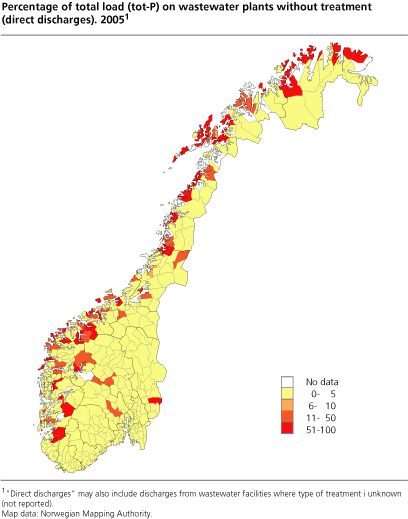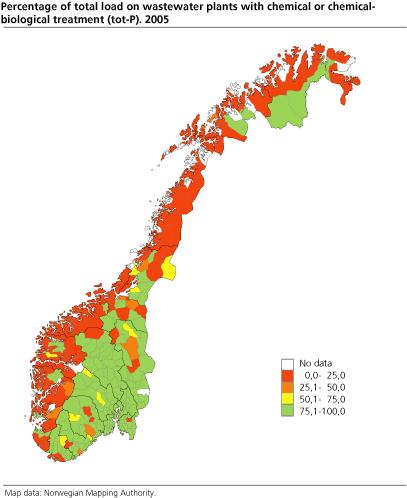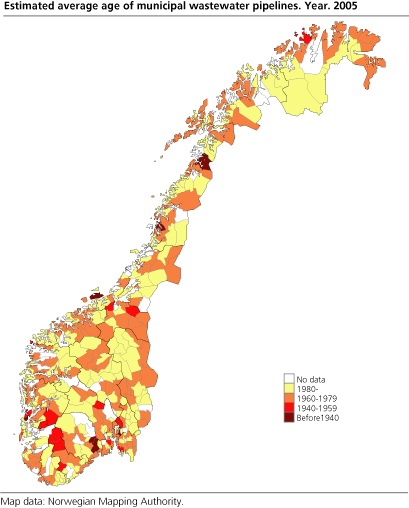Content
Published:
This is an archived release.
Better wastewater treatment along the North Sea
The newly released KOSTRA figures show that 98 per cent of the inhabitants along the North Sea is connected to advanced treatment plants in 2005. This constitutes a 1 per cent increase since last year.
The KOSTRA figures that 98 per cent of the inhabitants connected to waste water plants larger than 50 PE (capacity, measured in hydraulic capacity) in the 10 North Sea Counties (Østfold to Vest-Agder) are connected to chemical and/or biological wastewater treatment plants, so-called advanced waste water treatment plants. This is a small increase from 97 per cent in 2004( 1 ). Around 20 municipalities, covering around 70 000 people, has not been estimated for due to lack of reported data.
The same figure outside the North Sea county area is 31 per cent. This is at the same level as in 2004.
Here the needs for treatment are substantially lower, primarily because of less critical recipient conditions. The pollution loads are generally also much lower here because of less densely populated areas and lighter industrial development in the area, although exceptions exist.
83 per cent of country population connected to municipal sewer system
In 2005, around 83 per cent of Norway's population was reported as connected to municipal sewage systems. In the North Sea counties the same figure was 86 per cent, and 79 per cent for the rest of the country.
The number of wastewater plants large than 50 PE has remained stable at around 2400, whereof some 1900 plants come under some sort of municipal ownership. In urban areas of southern Norway, inter-municipal ownership is common. Small plants designed for less than 50 persons are still common in areas with scattered population. The majority of these plants are individual plants not connected to the municipal sewer system.
| Selected key indicators for the North Sea counties compared to the rest of the country. 2004 and 20051 |
| The whole country | The North Sea counties | Rest of the counties | |||||||||||||||||||||||||||||||||||||
|---|---|---|---|---|---|---|---|---|---|---|---|---|---|---|---|---|---|---|---|---|---|---|---|---|---|---|---|---|---|---|---|---|---|---|---|---|---|---|---|
| 2004 | 2005 | 2004 | 2005 | 2004 | 2005 | ||||||||||||||||||||||||||||||||||
| Total number of wastewater plants reported | 2 364 | 2 391 | 627 | 639 | 1 737 | 1 752 | |||||||||||||||||||||||||||||||||
| Plants with municipal ownership | 1 945 | 1 919 | 429 | 429 | 1 516 | 1 490 | |||||||||||||||||||||||||||||||||
| Per cent of population connected to the municipal sewerage system | 82 | 83 | 85 | 86 | 79 | 79 | |||||||||||||||||||||||||||||||||
| Per cent of population connected to advanced treatment plants | 69 | 72 | 97 | 98 | 31 | 31 | |||||||||||||||||||||||||||||||||
| Per cent of population connected to plants with chemical treatment | 40 | 39 | 51 | 48 | 25 | 26 | |||||||||||||||||||||||||||||||||
| Per cent of population connected to plants with biological-chemical treatment | 27 | 31 | 45 | 49 | 3 | 3 | |||||||||||||||||||||||||||||||||
| Per cent of population connected to plants with other types of treatment | 26 | 25 | 5 | 3 | 57 | 58 | |||||||||||||||||||||||||||||||||
| Per cent of population connected to plants without treatment | 6 | 5 | 0 | 0 | 15 | 13 | |||||||||||||||||||||||||||||||||
| 1 | Data from 2004 have been updated since they were released in 15 June 2005. |
The figures presented in the table above must be considered as preliminary, and may be adjusted in the final publication later this year on the discharges and treatment in the municipal wastewater sector 2005.
0,56 per cent renewal of the municipal wastewater pipeline system
Annual renewal rate of wastewater pipelines is reported to be around 0.56 per cent per year in 2005. This equals a lifetime of around 180 years, given the same renewal rate also in the future. Renewal of wastewater pipelines is of critical importance in order to prevent damage to buildings and pollution to the environment through leakages. Leaking pipelines can also contribute to increased treatment costs as surface water and groundwater may enter the pipelines.
In 2005 it was estimated around 510 number of closed cases of basement flooding where municipality has accepted liability and around 4 500 sewage overflows in pipeline, storm water system and manhole covers.
Regionally, annual average renewal rate is about 0.53 per cent in the North Sea counties, and around 0.62 per cent for the rest of the country. The pipeline system, however, is longer and more extensive in the North Sea counties, thus total renewal is somewhat larger there (around 100 kilometres) compared to the rest of the country (around 85 kilometres).
Estimations show that there are totally around 34 410 kilometres of municipal wastewater pipelines in the country. The 3 per cent increase since last year is largely due to changes and updates made by the municipalities. The average age of the municipal wastewater pipelines is estimated to 28 years, whereof 11 per cent installed before 1940, 9 per cent between 1940-59, 34 per cent between 1960-80, and the remaining 46 per cent were laid down after 1980.
7 per cent increase in annual fees
On country level, the annual feel was on the average NOK 2 649 in 2006. This constitutes a 7 per cent increase compared to 2005. The figures are based on stipulated water usage. On regional level, the inhabitants in the county of Østfold experienced the highest annual fees with an average of NOK 3 902. Oslo with its annual fee of NOK 1 432 was lowest.
The fee per water used has remained relatively stable since to last year. The average fee level varied between NOK 16,58 in Hedmark (highest) and NOK 6,36 in Finnmark (lowest). The connection fee - high-level connection fee - was highest in municipalities of Akershus with an average of NOK 23 100. Please take notice that the fee figures presented here are estimated data, and not derived directly from of the KOSTRA key figures.
Tables:
The statistics is now published as Municipal wastewater.
Contact
-
Gisle Berge
E-mail: gisle.berge@ssb.no
tel.: (+47) 48 12 19 97



